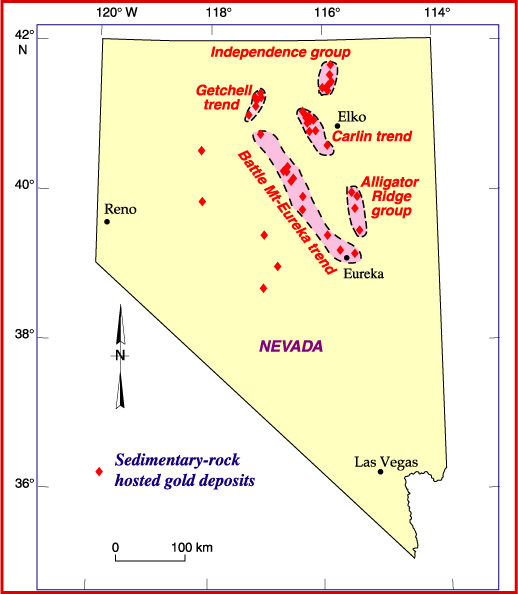Carlin Trend on:
[Wikipedia]
[Google]
[Amazon]

 The Carlin Unconformity or Carlin Trend is a geologic feature in northeastern
The Carlin Unconformity or Carlin Trend is a geologic feature in northeastern
Newmont's reserve history on the Carlin Trend, 1965 - 2001
by Dean G. Heitt, Newmont Mining Corporation * {{coord missing, Nevada Unconformities Carboniferous events Carboniferous geology of Nevada Gold mining in Nevada

 The Carlin Unconformity or Carlin Trend is a geologic feature in northeastern
The Carlin Unconformity or Carlin Trend is a geologic feature in northeastern Nevada
Nevada ( ; ) is a state in the Western region of the United States. It is bordered by Oregon to the northwest, Idaho to the northeast, California to the west, Arizona to the southeast, and Utah to the east. Nevada is the 7th-most extensive, ...
which represents a period of erosion or non-deposition likely associated with a collision between a tectonic
Tectonics (; ) are the processes that control the structure and properties of the Earth's crust and its evolution through time. These include the processes of mountain building, the growth and behavior of the strong, old cores of continents ...
crustal block called a terrane
In geology, a terrane (; in full, a tectonostratigraphic terrane) is a crust (geology), crust fragment formed on a tectonic plate (or broken off from it) and Accretion (geology), accreted or "Suture (geology), sutured" to crust lying on another pla ...
and the North American Plate
The North American Plate is a tectonic plate covering most of North America, Cuba, the Bahamas, extreme northeastern Asia, and parts of Iceland and the Azores. With an area of , it is the Earth's second largest tectonic plate, behind the Pacif ...
. The collision occurred during the Mississippian Period, about 350 million years before present. The collision is associated with the Antler Orogeny
The Antler orogeny was a tectonic event that began in the early Late Devonian with widespread effects continuing into the Mississippian and early Pennsylvanian. Most of the evidence for this event is in Nevada but the limits of its reach are un ...
.
The collision induced higher crustal temperatures and pressures which produced numerous hot springs along the suture zone. Several episodes of subsurface magmatism are known to have occurred subsequent to the collision, associated with tectonic forces affecting the entire Basin and Range Province
The Basin and Range Province is a vast physiographic region covering much of the inland Western United States and northwestern Mexico. It is defined by unique basin and range topography, characterized by abrupt changes in elevation, alternating ...
. During each of these episodes, and particularly during the Eocene
The Eocene ( ) Epoch is a geological epoch that lasted from about 56 to 33.9 million years ago (mya). It is the second epoch of the Paleogene Period in the modern Cenozoic Era. The name ''Eocene'' comes from the Ancient Greek (''ēṓs'', " ...
epoch, hot springs brought dissolved minerals toward the surface, precipitating them out along fissures. Among these minerals were gold
Gold is a chemical element with the symbol Au (from la, aurum) and atomic number 79. This makes it one of the higher atomic number elements that occur naturally. It is a bright, slightly orange-yellow, dense, soft, malleable, and ductile me ...
and silver.
The Carlin Gold trend is one of the world's richest gold mining districts. It is a belt of gold deposits, primarily in Paleozoic
The Paleozoic (or Palaeozoic) Era is the earliest of three geologic eras of the Phanerozoic Eon.
The name ''Paleozoic'' ( ;) was coined by the British geologist Adam Sedgwick in 1838
by combining the Greek words ''palaiós'' (, "old") and ' ...
limy sediments
Sediment is a naturally occurring material that is broken down by processes of weathering and erosion, and is subsequently transported by the action of wind, water, or ice or by the force of gravity
In physics, gravity () is a fundame ...
, that is about wide and long, extending in a north-northwest direction through the town of Carlin, Nevada
Carlin is a small city located near the western border of Elko County in northeast Nevada, west of the city of Elko. It is part of the Elko Micropolitan Statistical Area. Carlin sits along Interstate 80 at an elevation of approximately . As of ...
. Gold was first discovered in the area in the 1870s, but there was little production until 1909, and only about 22,000 ounces was produced through 1964. By 2008, mines in the Carlin Trend had produced over 70 million ounces of gold, worth around $85 billion at 2010 prices.
See also
*Carlin–type gold deposit
Carlin–type gold deposits are sediment-hosted disseminated gold deposits. These deposits are characterized by invisible (typically microscopic and/or dissolved) gold in arsenic rich pyrite and arsenopyrite. This dissolved kind of gold is c ...
* Gold mining in Nevada
Gold mining in Nevada, a state of the United States, is a major industry, and one of the largest sources of gold in the world. In 2018 Nevada produced , representing 78% of US gold and 5.0% of the world's production. Total gold production recorde ...
* John Livermore
John Sealy Livermore (April 16, 1918 – February 7, 2013) was an American geologist who discovered or helped to discover four major gold deposits in northern Nevada.
Livermore was born in San Francisco, California, and was descended from ...
* Ralph J. Roberts
References
Further reading
* * *Newmont's reserve history on the Carlin Trend, 1965 - 2001
by Dean G. Heitt, Newmont Mining Corporation * {{coord missing, Nevada Unconformities Carboniferous events Carboniferous geology of Nevada Gold mining in Nevada